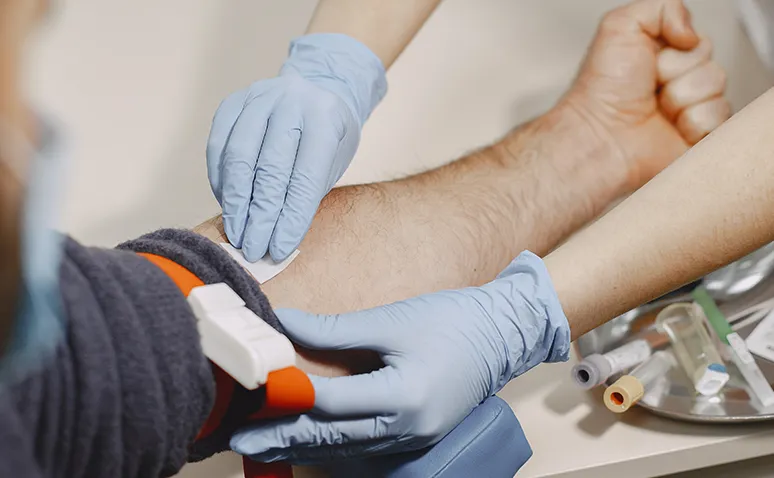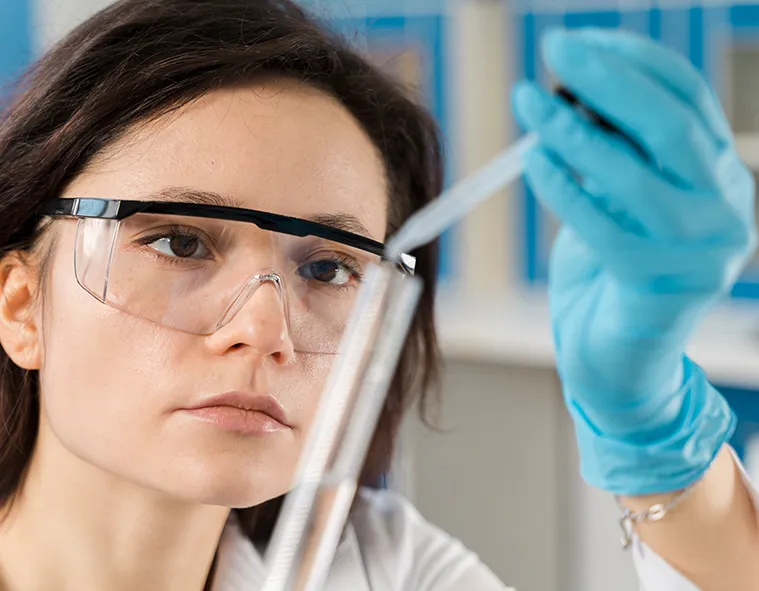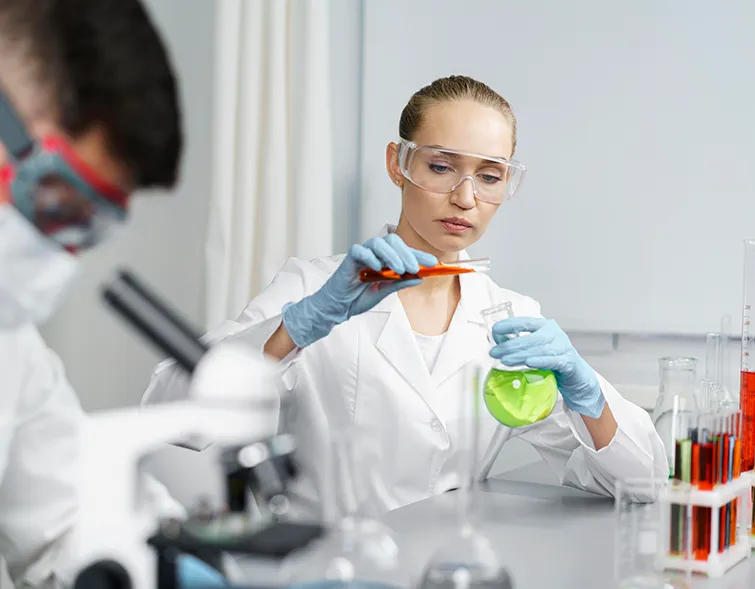
Before recognizing cancer, it is necessary to overview the normal functioning of the genetic structure.
How does genetic structure function in the human body?
In human body, there are about 100 trillion cells with different functions and structures and those cells, make up tissues and organs. There genes are packed within the nucleus of each cell and they initiate their functions depending on the need of the cell. The cell may either be proliferating or producing proteins for the spesific metabolic functions of the organ where it is located. The basic building block of these genes is the DNA molecule. DNA (Deoxyribonucleic acid), is made up of molecules called purine and pyrimidine bases that pair with specific bonds to form a helical structure packed in the chromosomes of that person. Each three bases represent the code for an amino acid, which is the basic structure of a protein molecule. These amino acids are arranged like a chain encoded by the gene and this code forms the protein which will be performing the specific function depending on the need of the cell. This function may be the building of the components of a new baby cell or a functional protein of the existing cell. Each day 100 million cells are replaced by the new cells as the death of the nonfunctional old cells occur.

In short, the life of a single cell follows the same logic as the life of a living being. When cells are young, they produce specific proteins for the function of the cell. When the cells are nonfunctional, depending on their lifetime or any cause of damage, they die (apoptosis) and new cells begin to multiply by dividing through a system called ‘mitosis’.
If the configuration the DNA has been disrupted by any cause like environmental factors, virutic and bacterial infections, silent genetic transitions, chemicals, radiation, UV, stress etc, which are yet unknown, this DNA has no longer the correct code for the normal cell protein. Thus, the protein synthesized from that genetic code is an unrecognized protein. This protein does not exist in the code of the normal genetic structure and starts to reproduce as a foreign and dysfunctional protein.
What is the mechanism of cancer?
In normal reproduction, there is a structure called ‘chromatin’ in the nucleus of cells that are packed and stored as the genetic code passing from the from the parent genes in a natural order. The nucleus contains the DNA codes for trillions of cells, and when it is time for that cell to reproduce, it receives the stimulus to make a new one and the construction of new cells begins. During this process, if the DNA code has been altered it is no longer the code for real cell structure and it becomes a cell which is called ‘an ectopic cell’. This cell is not recognized by the neighbouring cells to stop the reproducing process, thus uncontrolled cell reproduction occurs. The ability of healthy cells to recognize each other and stop further reproduction is called ‘contact inhibition’. This new tissue formation and growth is called neoplasm. Neoplasms may be carried as individual cells to the other tissues, or they can grow together and accumulate in the same place where they have been originated. If they grow in a particular location, they become a tumor. If this tumor grows very slowly and does not give harm to its environment or stops growing after it has multiplied and stays in the same place in a controlled manner, we call it a benign tumor. Sometimes, a benign neoplasm may undergo another mutation within itself and form a different type of cell, which can grow rapidly and invasively spreading into its surroundings. The damaged DNA may mutate continuously and became a more potent pathogen. As the mutations increase uncontrollably, they spread to other tissues, which is called metastasis. These are cancer cells and are called malignant. Since these cells have now mutated in many locuses of the defective DNA structure, they become more aggressive and undestroyable, therefore spreading may increase rapidly.
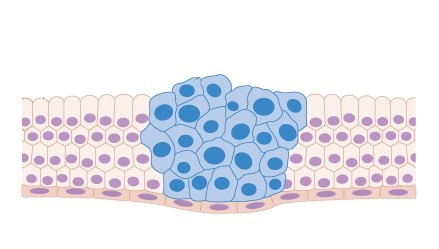
Can the body repair its own DNA damage ?
The branch of science that studies this process is called Oncogenetics.
In living organisms, there are also genes that correct DNA damage and repair the structure formed with the wrong code. These are called oncogenes. Sometimes, the cell with this altered genetic code realizes that it does not belong to that tissue where its synthesized and destroys itself. This is called apoptosis (cell suicide). However, if the cell is unable to do this, it may start to reproduce as it is. Oncogenes divide into two subclasses;
These are, Tumor Suppressor Genes and Pro Oncogenes.
Normal cells contain some genetic codes that control the division (the p53 and p21 genes). These are normally responsible for repairing a damaged DNA, stopping the division of the cells formed and destroying the foreign cell structure. The general name for these genes is Tumor Suppressor Genes. They are passed on to the child in equal amounts from the mother and father. If one is broken and the other is working, the correction process takes place with one of the gene pairs but, if both of these genes are mutated, they cannot do their jobs and the new cell continues to multiply.
The second mechanism is called the Protooncogenes, which are also protective genetic codes. These are factors that function for the correct cell division and growth. They ensure that growth is following the right cellular signals. These genes are also encoded by a spesific DNA locus and if a DNA damage occurs within this code, the normal production of protooncogene is disrupted and harmful Oncogene formation is triggered.
In summary, inactivation of tumor suppressor genes and activation of protooncogenes to oncogenes are the most important factors in the formation and proliferation of cancer and the inability of the organism to protect itself.
What are the stages of cancer and how are they expressed?
Defining the stage of cancer is a clinical tool for the doctor to decide the treatment policy. There are two different universal systems to define the stage of cancer. The TNM system defines the tumor type, node (nodule) and metastasis. T stands for the size of the tumor, N for the presence of cancer in the lymph nodes and M for metastasis. The 1 to 4 numeration represents the severity of cancer. Another definition is represented by Roman numerals (I-IV). This system is more often used. According to this:
Stage I: Indicates that the cancer is minor and localized within the organ.
Stage II: The tumor is larger than Stage I, but has not yet metastased to the surrounding tissues or is present in the lymph nodes close to the cancerous cell.
Stage III: The cancer is usually large and has metastased to surrounding tissues and nearby lymph nodes.
Stage IV: The cancer has spread from where it started, to other organs such as liver and lungs. This is also called secondary metastatic cancer.
Another definition is how the cells are differentiated. If the cells are similar to those in normal tissue, they are called well-differentiated cells and indicate that the tumor is likely to grow and spread slowly. Poorly differentiated or undifferentiated cells are very abnormal. They are irregularly shaped and are more likely to spread faster to the surrounding tissues.
How does cancer develop after it occurs?
Every organ has an outer membrane that protects the cells from external factors. As cancerous cells grow among these normal cells, they need oxygen and nutrients from the blood like other cells, so they secrete a substance called angiogenetic factor to attract blood vessels towards them. In this way, they get the life source they need.
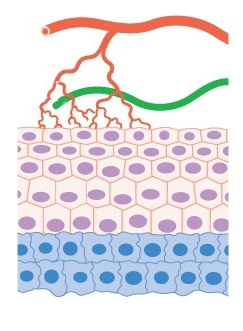
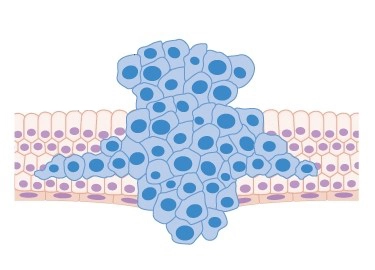
How can we distinguish the types of cancer?
Cancer is classified under three types;
- According to the organ of origin
- According to the organ it affects
- According to whether it is localized or malignant
1-According to the organ of origin
– Carcinoma (a type of cancer in epithelial cells of that organ); for example, basal cell carcinoma and breast cancer.
– Sarcoma; solid tumors of connective tissues; for example, osteosarcoma.
– Leukemias (cancer of white blood cells), myeloma (cancer of plasma cells) and lymphomas (cancer of the lymphatic system). For example, multiple myeloma.
2-According to the organ it affects; lung cancer, breast cancer, liver cancer, brain cancer, thyroid cancer, etc.
3- According to whether it spreads or not. If the tumor is benign, it grows slowly and is named according to the organ (adenoma, lipoma). That is, the name of the organ and the suffix -oma.
If the tumor is malignant, this is expressed by adding the suffix – carcinoma to the name of the organ in which it is located (adenocarcinoma).
What are the factors promoting cancer development?
Age
Smoking
Obesity
Genetic predisposition
UV rays
Environmental pollution
Stress
Alcohol
Viral and bacterial infections
Artificially produced foods
The cancer-causing agents of these substances, i.e., their contents, are called carcinogens.
What are the symptoms that may bring out cancer suspection?
Although these symptoms can be due to a wide range of other causes, according to the Cleveland Clinic in the US, symptoms may include irregularities in the bowel and bladder system, wounds that do not heal, unexpected bleeding, palpable lumps and bumps in any organ, difficulty swallowing and digesting, marked visual changes in moles or warts, wheezing, coughing or hoarseness, extreme fatigue, loss of appetite, unexplained weight loss.
Can cancer be detected early?
When there are no symptoms at all, some tests have been defined to search for the probability of cancer. These are not definitive tests and may not exactly point out the existence of cancer. These are called screening tests and are the only available tests that would lead to more detailed examination when there is only cancer suspicion. They may be false positive or false negative. However, if positive, they give the chance for further examination and possibly for early diagnosis which is very helpful for easier treatment.
Screening tests begin with a physical examination and health history, questioning about the person’s lifestyle and recording any other treatment received. The second stage involves laboratory tests. Tests related to the function of the organs, tissues. Blood, urine, t and body fluids are the samples. Another form of screening is imaging. Tomography for lung cancer, ultrasonography and mammography for breast cancer, sigmoidoscopy, colonoscopy and endoscopy for colon and digestive system cancers. Pathologic examinations such as smears, biopsies and genetic tests can be selected according to the recommendation of the doctor leading the screening.
Unfortunately, except for the imaging of solid tumors today, such screening may not give exact results when the cancer is at a size that cannot be detected by physical examination and imaging procedures. If the results appear negative, the underlying cancer case may not be detected for any reason due to the nature of cancer. Nevertheless, the possibility of early detection should not be ignored. Cancer types like breast cancer, gastrointestinal system cancers, cervical and uterine cancers, lung cancer (especially in heavy smokers), are more common and easily treated by early diagnosis
How and according to what are cancer treatments administered?
According to the American Cancer Society (ACS) radiotherapy, chemotherapy, immunotherapy, targeted therapies, radiotherapy and surgery treatments are the present treatment methods. If the tumor is localized surgery might be the first choice but in order to rule out the possibility of metastasis, the procedures which are called the ‘systemic treatments’ may be followed.
Surgery is either the removal of a tissue or organ and its pathological examination, sometimes even in the absence of symptoms. For diagnosed cancers, the most important question is the urgency of surgery.
The difference between chemotherapy, radiotherapy and surgical removal of tissue is that chemotherapy can find the tumor not only where it is located, but also where it has spread. The chemicals travel to the other possible tissues or cells through the blood and this makes the treatment nature more systematic. Radiation therapy is aimed at a specific area. In this case, it is not effective in treating metastasis. Chemotherapy may also be applied for the comfort of the patient if the cancer is highly metastasized and beyond the scope of treatment. The aims of chemotherapy can be to destroy the cancerous cell by breaking it down, to destroy cancerous cells that may remain after surgery, and to support other treatment systems.
Drugs used for chemotherapy can be choosen by the doctor considering some criterias like their chemical interactions with other drugs and side effects. Other criterias may be the ability of the drug to prevent the mitotic power of the cell by damaging the DNA of the cell, ability to cross the blood-brain barrier, disrupting intracellular metabolism, inactivating metabolic enzymes, and their corticosteroid effects to prevent vomiting and allergic reactions.
Another method for treatment is targeted therapy. This treatment is planned according to the characteristics of the cancerous cells. Cancer cells, like all other living cells, are composed of special proteins and receptors for their relationships with their environment, their metabolic needs, their functions and their evolution. Investigating those specific proteins and other components in cancer cells, drugs have been developed to act only on these components in cancer cells without giving harm to the normal cells. These are also effective in preventing the recurrence of cancer. However, unfortunately, today they are only used in some types of cancer because, mutation rates and causes of cancer types are various. Another definition for targeted therapy is ‘smart drug’. Its superiority over chemotherapy is that, it does not affect healthy cells and prevents the proliferation of cancer cells. However, since it is specific to the cancer type and cell, and since cancers such as colon cancer and breast cancer have a variable gene structures according to the individual, the application becomes difficult regarding the species of cancer. Researchers are still working on producing more drugs specific to various cancer types. Today, these treatment methods are still accompanied by chemotherapy, radiotherapy and surgery to obtain effective results.
Another type of treatment is the ‘hormone therapy’. It is used in breast, prostate and uterine cancers. This is because, these organs produce cells that proliferate faster when the sexual cycle is constantly stimulated by hormones. By inhibiting the effect of these stimulating hormones, the hormonal stimulation on cell proliferation can be eliminated and the cancer can be slowed down.
Another method used today is ‘immunotherapy’. It is based on the immune system recognizing and attacking the cancer cell just like a foreign bacteria or virus. The immune system, promotes the production of antibodies to fight the infections caused by viruses or bacterias. Antibodies, specifically recognize and attack the foreign organism (antigen). Based on this mechanism, researchers have designated antibodies that recognize cancerous cells under laboratory conditions. These are called monoclonal antibodies. The spesific cell component of cancer cell is identified and antibodies against those components are produced. When these antibodies are targeted to the cancer cell, the cancer cell will be destroyed. In fact, this may be considered as another version of targeted therapy. These antibodies can even be made more effective by administering them in conjunction with certain drugs. In some cases, they are also supported by the effect of radiation on the target cell by binding the antibodies to a radioactive substance. This treatment method is also referred to as a cancer vaccine. Furthermore, immunotherapy, is modified by combining the antibodies with inactive bacteria and presenting this compound to the cancer cell. Since the body’s normal immune cells will also be stimulated against the bacteria, the natural antibodies formed against the bacteria also function to destroy the cancerous cell.
Immune therapies are still the subject of further investigations.
Is there a cancer vaccine?
Vaccines are useful for some types of cancer because some cancers are caused by viruses. Cervical, anal, laryngeal, vaginal, vulvar and penile cancers can also be caused by HPV (Human Papilloma Virus) infection. The vaccine protects against the cancer-causing effects of these infections by destroying the virus before it damages the DNA structure of the healthy tissue cell.
The Hepatitis B vaccine is of great importance in protecting against liver cancer. Hepatitis B vaccine creates a defense against liver cancer in patients who have chronic Hepatitis B infection. Hepatitis B virus still keeps its importance with its high risk of developing liver cancer for patients who have not been vaccinated.
Is the Covid vaccine a reason for the increase in cancer cases?
When the mechanism of cancer occurence is considered, it is very difficult to determine whether the vaccine or the virus itself increases the incidence of cancer, since many different factors and cell mutations are involved. Therefore, long-term prospective and retrospective studies and genetically based case studies should be done to support this pretention. Since this is not possible for the time being, those comments are not scientifically acceptable. No such evidence has been published or reported.

